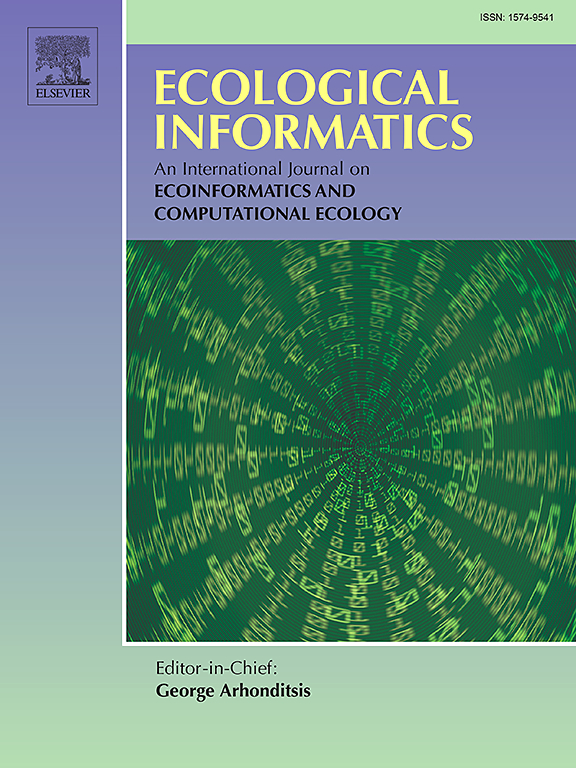来自近距离光谱数据的北方泥炭地土壤水分含量
IF 7.3
2区 环境科学与生态学
Q1 ECOLOGY
引用次数: 0
摘要
泥炭地在全球碳循环中发挥着关键作用。它们的碳交换功能对湿度条件和地下水位高度敏感,而这些条件和地下水位日益受到气候变化和土地利用变化的威胁。虽然卫星遥感能够大规模监测泥炭地的湿度状况,但精确的近距离测量对于校准和验证这些方法至关重要。以前的近距离研究通常集中在有限数量的泥炭地地点的数据上,这在理解不同泥炭地类型和气候带的土壤表面湿度估算方面存在空白。我们的研究利用爱沙尼亚和芬兰13个北部泥炭地的近距离高光谱场测量来解决这些差距,这些泥炭地横跨半北方到北极地区。我们评估了多种技术,包括光谱指数、连续谱去除、全谱分析和连续小波变换(CWT),以及核偏最小二乘(KPLS)回归。此外,我们将高光谱方法与模拟多光谱数据进行了比较。结果表明,CWT处理的高光谱数据提供了不同泥炭地环境下最准确的土壤湿度估计(R2 = 0.65, RMSE = 17.7%)。此外,基于多光谱波段的模型具有中等的预测精度(R2 = 0.53, RMSE = 20.4%),与全光谱分析(R2 = 0.58, RMSE = 19.4%)具有竞争力。将泥炭地划分为微营养型和全营养型进一步提高了预测精度,特别是对微营养型的预测精度(CWT: R2 = 0.74, RMSE = 15.9%)。光谱指数表现不佳(R2≤0.26,RMSE≥25.8%),可能不适合大规模遥感应用。本文章由计算机程序翻译,如有差异,请以英文原文为准。
Soil moisture content of northern peatlands from close-range spectral data
Peatlands play a critical role in the global carbon cycle. Their carbon exchange functions are highly sensitive to moisture conditions and water table levels, which are increasingly threatened by climate change and land-use modifications. While satellite remote sensing enables large-scale monitoring of peatland moisture conditions, precise close-range measurements are essential for calibrating and validating these methods. Previous close-range studies have typically focused on data from a limited number of peatland sites, creating gaps in the understanding of soil surface moisture estimation across diverse peatland types and climatic zones. Our study addressed these gaps using close-range hyperspectral field measurements from 13 northern peatlands spanning hemiboreal to Arctic regions in Estonia and Finland. We evaluated multiple techniques, including spectral indices, continuum removal, full-spectrum analysis, and Continuous Wavelet Transform (CWT), with Kernel Partial Least Squares (KPLS) regression. Additionally, we compared hyperspectral methods with simulated multispectral data. Our results showed that hyperspectral data with CWT processing provided the most accurate soil moisture estimations across diverse peatland environments (R2 = 0.65 and RMSE = 17.7 %). Additionally, the model based on multispectral bands, achieved moderate prediction accuracy (R2 = 0.53 and RMSE = 20.4 %), which was competitive with full-spectrum analysis (R2 = 0.58 and RMSE = 19.4 %). Separating peatlands into minerotrophic and ombrotrophic categories further improved prediction accuracy, particularly for the minerotrophic sites (with CWT: R2 = 0.74 and RMSE = 15.9 %). In contrast, spectral indices performed poorly (R2 ≤ 0.26 and RMSE ≥ 25.8 %), suggesting that they may be unsuitable for large-scale remote sensing applications.
求助全文
通过发布文献求助,成功后即可免费获取论文全文。
去求助
来源期刊

Ecological Informatics
环境科学-生态学
CiteScore
8.30
自引率
11.80%
发文量
346
审稿时长
46 days
期刊介绍:
The journal Ecological Informatics is devoted to the publication of high quality, peer-reviewed articles on all aspects of computational ecology, data science and biogeography. The scope of the journal takes into account the data-intensive nature of ecology, the growing capacity of information technology to access, harness and leverage complex data as well as the critical need for informing sustainable management in view of global environmental and climate change.
The nature of the journal is interdisciplinary at the crossover between ecology and informatics. It focuses on novel concepts and techniques for image- and genome-based monitoring and interpretation, sensor- and multimedia-based data acquisition, internet-based data archiving and sharing, data assimilation, modelling and prediction of ecological data.
 求助内容:
求助内容: 应助结果提醒方式:
应助结果提醒方式:


